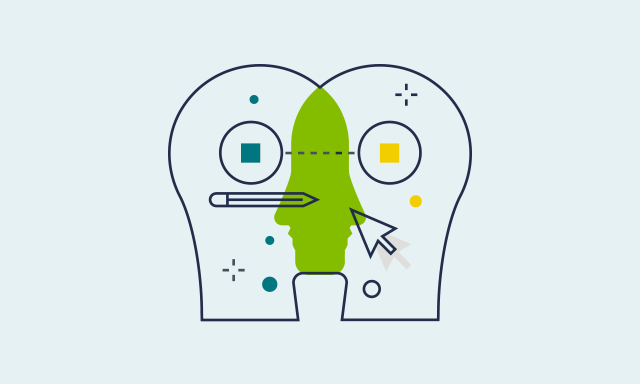

 Article
Article

 The crux of design thinking is that it embraces both creativity and analytical thinking to solve problems; two sides of the design thinking coin, both are essential to the design thinking process.
The crux of design thinking is that it embraces both creativity and analytical thinking to solve problems; two sides of the design thinking coin, both are essential to the design thinking process.

As an increasingly popular approach to business innovation, the crux of design thinking is that it embraces both creativity and analytical thinking to solve problems; two sides of the design thinking coin, both are essential to the design thinking process.
As such, one key to design thinking is for designers to empathize with those who see the world through what Stanford psychologist Carol Dweck calls a “fixed mindset” — many of whom may be corporate or bureaucratic managers — and vice versa. Having learned at an early age that “life’s a test, try not to look stupid,” the fixed mindseter (whom we call “George”) usually digs deeply into a specialty and masters the intricacies of it, while designer-types, who usually enjoy what Dweck calls a “growth mindset,” see life as a journey of discovery and, therefore, have developed a more diverse repertoire.
There is a natural tension between these two mindsets, as one usually sticks to the same silo, mastering details and becoming reticent about disruptive change, and the other (whom we call “Geoffrey”) bounces in and out of silos, easily bored with those same intricacies and excited by the weird and the new. Like an exhilarating relationship, the smart Geoffrey and smart George become the “opposites who attract,” instead of the antithetical couples who get bogged down in their differences. Keeping the “creative types” and the “numbers people” on the same wavelength produces great ideas firmly anchored in the real world because Geoffreys have the propensity to embrace innovative ideas and Georges have the wisdom to devise tests for managing — not avoiding — any risks associated with Geoffreys’ imagined futures.
The Geoffrey personality dominates in what we call the front end of design thinking, the What is and What if questions, and George’s natural home turf is in the back end, What wows and What works. If George withholds his natural skepticism until several of Geoffrey’s ideas are napkin pitched (when the organizational case for any new idea begins analysis), he is crucial for not allowing pie-in-the-sky ideas to overcome steely-eyed reality thinking. Too often, upper management can be easily awed by creative types and forget that the Geoffreys of the world, highly invested in their “brilliant” ideas, can become blind to any potential flaws. Identifying promising ideas is Geoffrey’s turf; ensuring that the promise is real is George’s.
Together, this is a formidable team. Opposed, this is no team at all. And design thinking, as practiced in the four-question, 15-step model, provides tools and methods for drawing the best of both personalities — whether that personality is literally two separate individuals or two aspects of the same human. One powerful tool is the methodology itself: When a George feels insecure during divergent “If anything were possible” thinking, he is still reassured he’s following a proven methodology and placated by checking off another box in that methodology. Other times, when the team needs to coalesce around design criteria, or assumption testing, or even very early in the process when teams decide whether design thinking is a solid approach for addressing their challenges, George’s attention to detail provides the foundation for Geoffrey’s creative thought.
Most design thinkers are Geoffreys and, like all humans, can face difficulty understanding others with different worldviews or mindsets. What seems simplicity itself to that Geoffrey personality might seem ridiculous to a George who may — because of his world view — rarely stick his hand up and chance being perceived stupid. The four-question methodology has Geoffreys all but begging Georges to expose flaws — at the right time and place, which is after What if creativity and before the expenditure of major dollars and resources when an organization pilots any new future.
A successful design thinker can use George and Geoffrey cooperation to truly empathize — different than sympathize or judge — with George. George is not stupid, or evil, or a “bean counter” who needs enlightened compassion, he’s rather essential to success because he helps Geoffrey recognize, and address, assumptions. He digs out the details that trip up even the best of ideas, and he does so after the ideas develop but while there is still time to solve those issues, not after Geoffrey has convinced the boss to turn over the checkbook — putting, of course, everyone’s necks on the line.
Jeanne M. Liedtka and Randy Salzman are authors of the upcoming book Design Thinking for the Greater Good: Innovation in the Social Sector (Columbia Business Press), a study of design-led innovation projects in government and social sectors.
Liedtka is an expert on the hot topic of design thinking and how it can be used to fuel innovation and organic growth.
Liedtka’s most recent books are The Catalyst: How You Can Lead Extraordinary Growth (named one of Businessweek’s best innovation and design books of 2009), Designing for Growth: A Design Thinking Tool Kit for Managers (winner of the 1800 CEO READ best management book of 2011), The Physics of Business Growth (2012) and Solving Business Problems With Design: 10 Stories of What Works (2013). Her latest book, Design Thinking for the Greater Good, studies design-led innovation projects in government and social sectors.
B.S., Boston University; MBA, Harvard University; DBA, Boston University